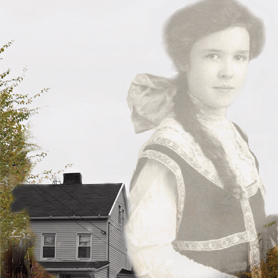In 1892, Maspeth was a sleepy farming town referred to as being “on the outskirts of the City of Brooklyn”. The untimely death of a popular young woman on a midsummer’s night unsettled many in the village and had them wondering whether or not her early demise was an accident or murder. For four days, the New York Times provided excellent coverage of the unfolding story. This is the final article in a three part series.
DEATH PROBABLY ACCIDENTAL
____________________________________
BELIEF INCREASING THAT LIZZIE BUHLER WAS NOT MURDERED.
July 5th – The mystery surrounding the death of pretty Lizzie Buhler, who was found dead on the railroad tracks near Maspeth, L.I., on Saturday morning, is not yet cleared up. It seems more than likely, in view of yesterday’s investigation that her death will prove to be accidental.
The residents of Maspeth, though they dearly love a mystery, are gradually coming to this view. The more it is looked into the more improbable the murder theory becomes. The suicide theory is still a possible one, but the girl’s social position tends to weaken the supposition that she had taken her own life for fear her shame would become known, which is the only reason she could have had for suicide.
The strongest argument which the upholders of the murder theory have is that the cowcatcher of the engine would throw the body to one side of the track if the girl was standing upright when struck.
More than half of the engines running over the Bushwick branch of the Long Island Railroad run with the tender first. It is more than probable that Lizzie Buhler was struck either by the rear of a car or of a tender. It would be very easy in that case for her to be thrown to the track and run over as she was.
The fracture of the skull was probably made by striking the end of a tie.
The efforts of the authorities to prove that a murder was committed, either by Joseph Easer or John Lauby, have met with no success. To be sure, young Easer disappeared. But he had been intimate with the girl and he may have disappeared on Saturday for fear he might be involved in the mystery. It developed that he had had a row with his father last Tuesday and had not been home since.
John Lauby’s father, mother and sister all swear that he was in bed at 9 o’clock. Franz Abt, the Flushing Avenue saloon keeper, says that Lauby was talking with the girl between 10 and 11 o’clock on Friday night. Mrs. Abt says it was not as late as that. She thinks it was between 9 and 10 o’clock. It is probable that both are mistaken.
Summing it all up, there is not a scrap of reliable evidence which would prove that either of the young men murdered the girl and put her body on the track to hide the crime.
The Pinkerton detective who is on the case thinks it was a murder. Yesterday afternoon he found an iron water pipe about two inches in diameter and two feet long, with one end covered with blood. He found it in Franz Abt’s horse shed and carried it away with much mystery. He said the bar was undoubtedly the instrument of death.
Unfortunately for his theory, there were four other similar iron bars in the shed with the ends covered with blood. Abt killed a calf on Friday afternoon and hung the carcass in the shed. The blood dripped down on the bars.
The body, when found, was on a small footpath which crosses the railroad diagonally from the direction of the Buhler’s house to the road where the girl intended to take the street car. There were no evidences of a struggle anywhere near and no marks as though a body had been dragged over the ground. A murder of this sort would have left some marks of a struggle.
The train which ran over the girl is probably the one which passes the crossing at 11:45 o’clock and arrives at Bushwick Station at 11:47. The engine was running tank first, and consequently, the headlight did not throw a light ahead. They run very fast at this point and there is a sharp curve a short distance from the footpath crossing.
The girl was probably walking along deep in thought. The reversed engine stole quickly and almost noiselessly on her. There was no cowcatcher to throw her on one side. She was struck squarely in the back, her head struck the deck beam of the tender, and it was then the skull was fractured. She was thrown diagonally across the rail, and her body was cut in two.
This is the most plausible and consistent theory of the death.
EASER PROVES AN ALIBI
______________________________
EXPLANATION OF LIZZIE BUHLER’S DEATH NOT YET FOUND
July 6th – Joseph Easer, the young man for whom the police have been looking in connection with the investigation into the death of Lizzie Buhler, whose body was found cut in two by a train on the railway track near Maspeth last Saturday, was found yesterday morning at his father’s house in East Williamsburg (now Ridgewood).
He was taken before Coroner Brandon at Newtown, and told the following story and denied emphatically any knowledge of how Lizzie Buhler met her death.
He said he left East Williamsburg at 7 o’clock Friday morning which was the day before Lizzie Buhler’s body was found, and went to Schemmel’s near the Brooklyn city line, to see an old chum of his, Eddie Wyman. He left Schemmel’s before noon and went to Michael Riley’s house on Maujer Street, between Morgan Avenue and Waterbury Street, Brooklyn, and from there went to New York.
He returned to Riley’s at 5 o’clock on Friday afternoon. He took supper and spent the evening with the family and spent the night at the Riley’s house. After breakfasting there Saturday morning, he went with Charles Sahr and his wife to Canarsie, returning Monday night.
Easer said that he had heard of Lizzie Buhler’s death from Sahr, Ben Binzer, and his own brother, Harry.
Easer denied ever having kept company or been intimate with Lizzie Buhler. He never took her to picnics or out driving.
He said he saw Lizzie Buhler with a strange man at Feldman’s picnic seven or eight weeks ago. The man was thin and tall, well-dressed and about twenty-one years old.
He said he last saw Lizzie Buhler the Sunday night before her body was found. He was with Annie Mullins and met Lizzie on Flushing Avenue. He denied that Lizzie cried or that there was a scene of any kind. He denied that Lizzie ever approached him for any misconduct or told him she was in trouble. He said he would not keep company with Lizzie as she had too many fellows for him.
He took his arrest very coolly and did not seem the least worried about the result. After his examination Coroner Brandon paroled Easer in the custody of Constable Holdsworth until the inquest today.
Later in the day detectives called at the Rileys’ house in Brooklyn, and the Rileys corroborated Easer and said he had spent last Friday evening and night at their house.
Last night the Pinkerton detective who had been employed on the case by Coroner Brandon went to Brooklyn to find Rosie Sanby, sister of John Sanby. This is the young woman who, it has been reported, got into some serious trouble through Lizzie Buhler, in consequence of which she left her home.
Coroner Brandon has received from train dispatcher James J. Reardon, of the Bushwick Railroad, the report of how Lizzie Buhler was run over by the 11:30 train on Friday night; four other trains must have passed over her body before its discovery in the morning. One engineer piloted the engine which drew all those trains, and the strange part of this is that if Lizzie were run over by the 11:30 train, that he did not see the body either on that or any of his subsequent trips over the spot.
This strengthens the theory that Lizzie Buhler was not, either dead or alive, run over by the 11:30 train on Friday night.




